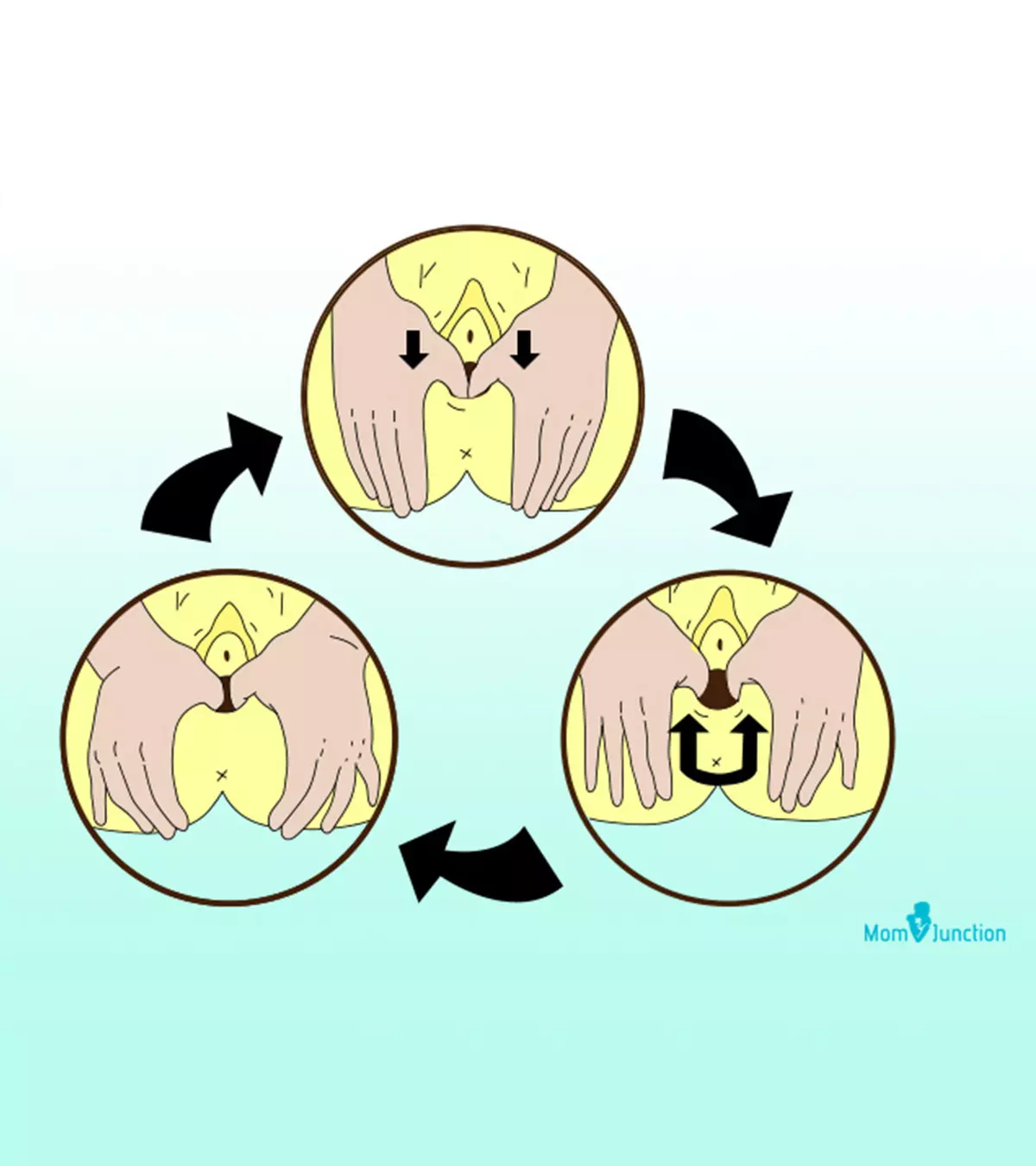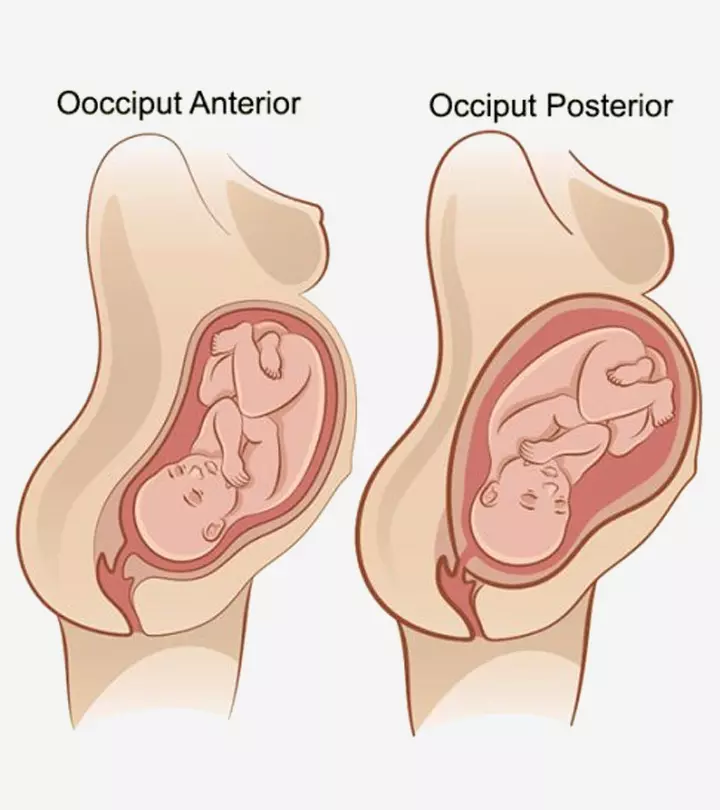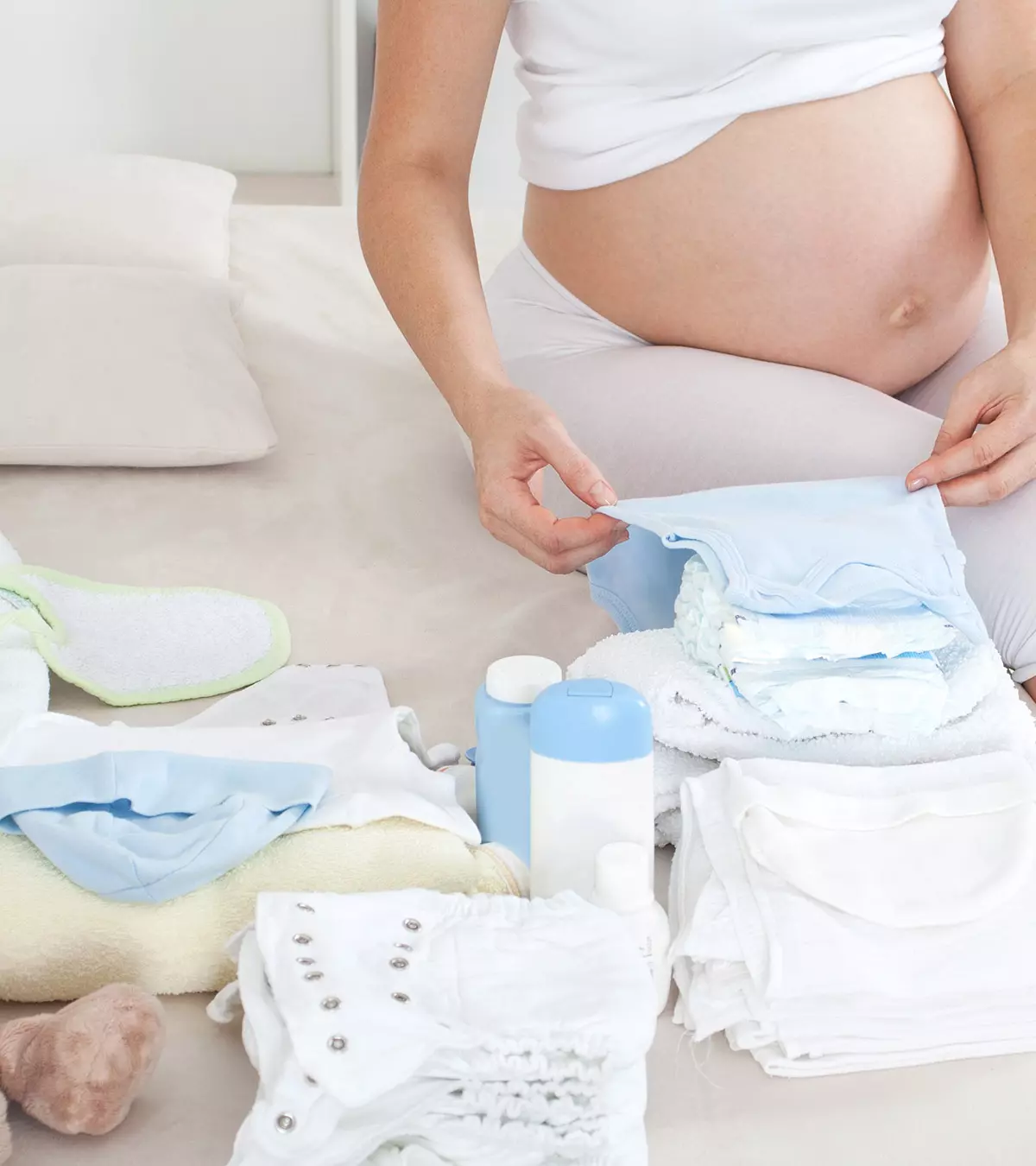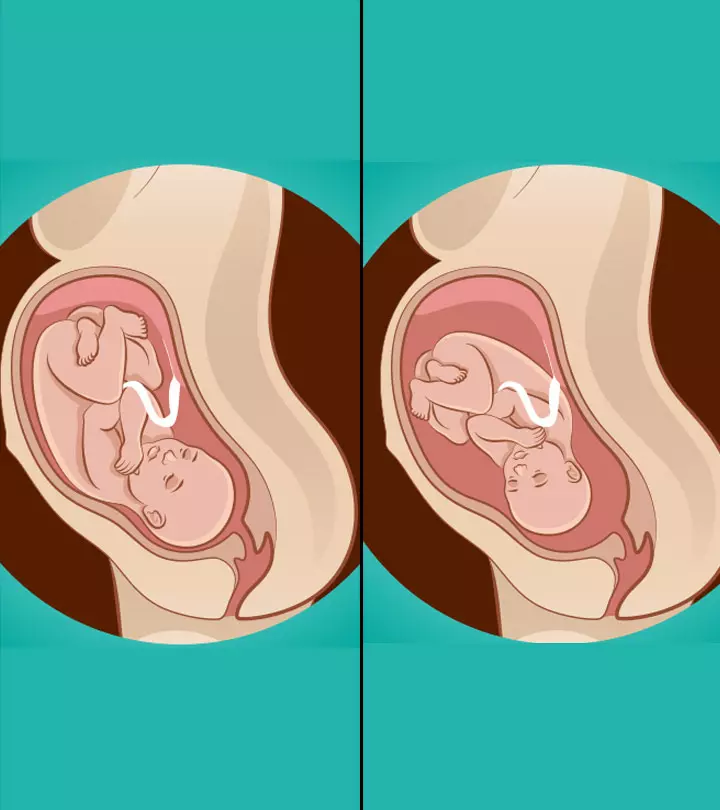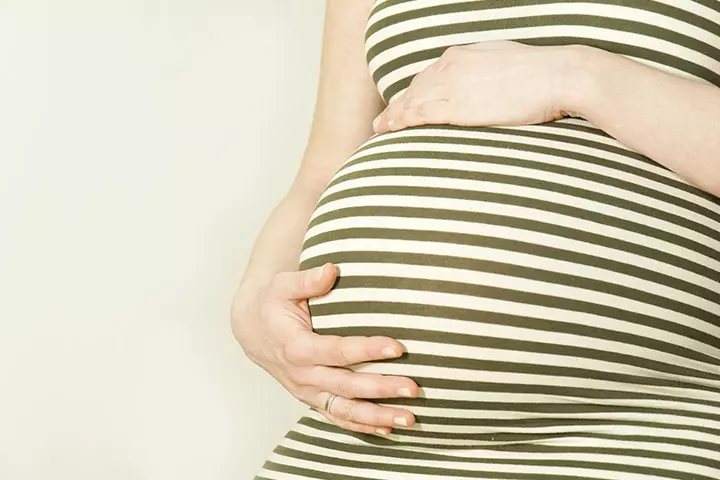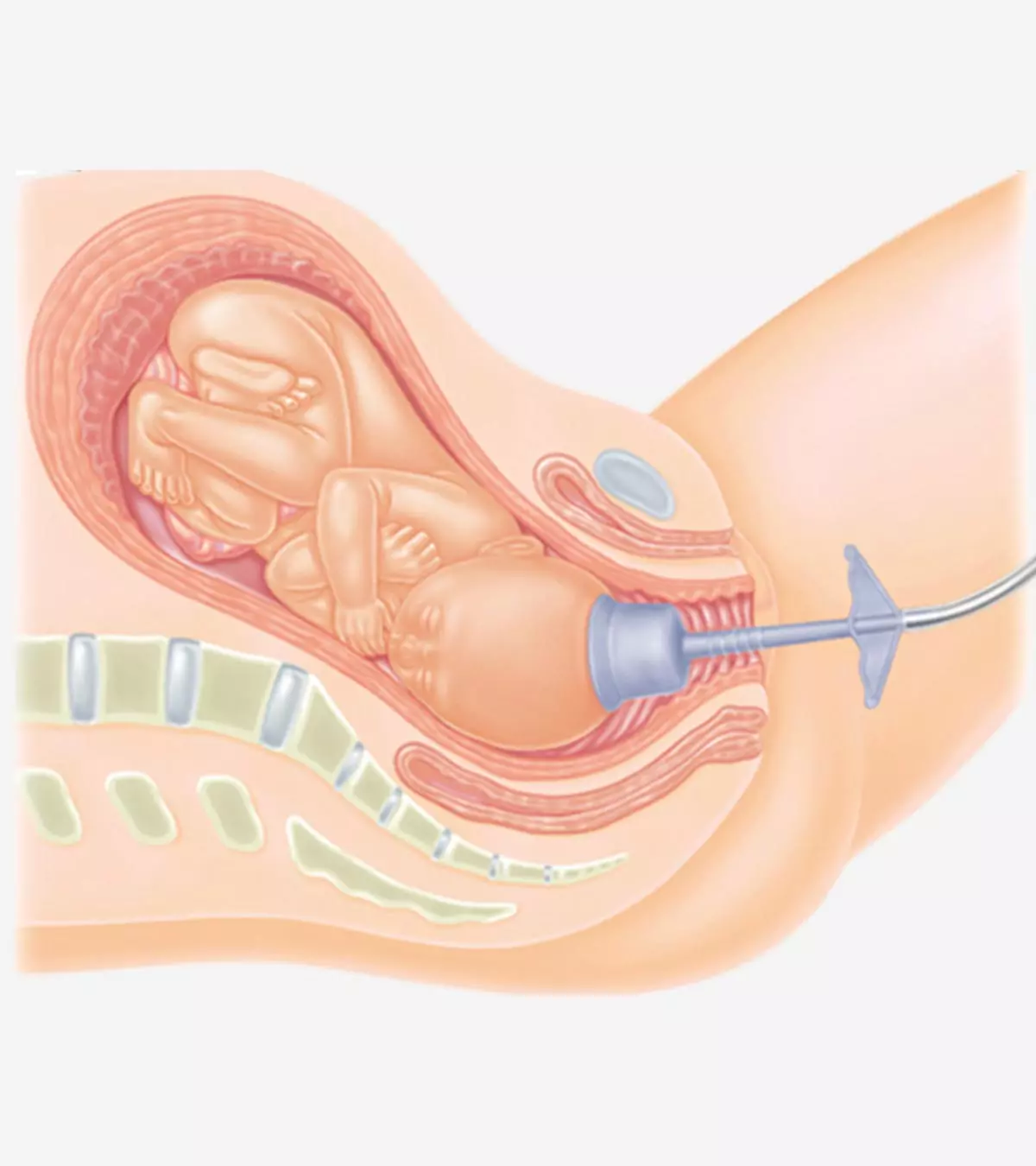
Image: ShutterStock

Most women deliver their babies in the traditional sleeping position. However, that’s not the only recommended position. If you want to explore the best positions during labor, your doctor or midwife may be able to help you.
Many women find it comfortable to change their position and keep moving during labor to ease the pain. Experimenting with different positions may help you find the best one to ease discomfort, help you be in control, and reduce the duration of labor.
Read this post to discover some of the best positions you can try during the first and second stages of labor, their benefits, and their drawbacks.
Key Pointers
- Finding the ideal position can ease pain, reduce discomfort, and shorten the time associated with the labor process.
- During the first stage of labor, positions such as hands and knees, birthing ball, sitting, and squatting can be used.
- To ease discomfort during pushing in the second stage of labor, positions such as lithotomy, semi-sitting, kneeling birth, and semi-reclining can be used.
- Beds with labor bars, labor stools, and labor tubs can also make the process easier.
Best Positions To Try During Labor
As you enter active labor, the contractions become strong and painful. During this time, you may not be in a position to take a decision on the labor position. Therefore, ask your doctor or caregiver to suggest some good positions to ease the birthing process. It’s worth noting that in the United States, about 67.9% of deliveries were vaginal in 2025, according to a CDC National Center for Health Statistics report. Thus, in order to prepare yourself for labor, you may also consider conducting some research or seeking advice from a birth consultant or childbirth educator beforehand.
 Did you know?
Did you know?Positions During The First Stage Of Labor
Here are some of the labor positions you can try (1) (2):
1. The hands and knees position

. You need to bend and support yourself on the knees and hands.
Benefits
- Helps ease back pain by taking off the pressure from the back. Boosts the oxygen supply to babies.
- Allows for rocking the hips.
- Convenient for the birth partner or birth assistant to give a back massage, counter pressure, and apply a cold and warm compress.
Drawbacks
- Arms may ache.
2. The birthing ball position
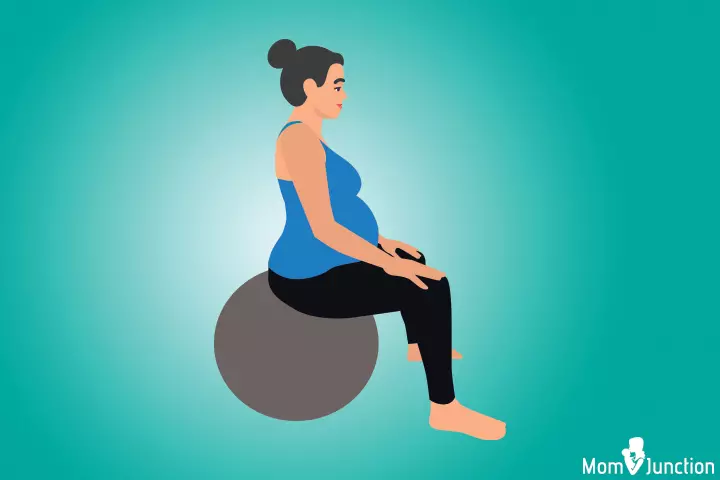
A birthing ball enables you to rock or sit on it, lean over it, or support the upper body while kneeling and squatting. It is helpful in hip movements during contractions.
Benefits
- Provides excellent support.
- Eases back pain.
- Encourages cervical dilation and helps the baby engage into the pelvis.
Drawbacks
Difficult to maintain balance; you may need somebody’s help.
3. The side-lying position

Lie on your side, and keep a pillow in between your knees. This labor position helps the baby rotate and engage into the pelvis. It makes you rest during labor and minimizes the muscular efforts.
Benefits
- Helps supply oxygen to the baby.
- Ideal position to try in case of high blood pressure.
- Offers relaxation during contractions.
- Can relieve hemorrhoidiSwollen, painful, and bleeding veins in the rectum and anus. pain.
- Lowers the chances of episiotomyiA procedure where an incision has to be made between the anus and vagina to facilitate childbirth. .
- Slows down a birth that is moving too fast.
Jessica, a mother of three and YouTuber, describes how side-lying positions helped her have a positive birth experience. She says, “I was ten centimeters (dilated), but I didn’t feel any urge to push. So for pushing, I got propped up on the bed so that I was in a kind of supported squatting position. I alternated this with side lying and lifting my leg… because the side lying was a great position for me and supported squat. I thought I would like to be on my hands and knees, but since the midwives didn’t suggest it, I got into my position and pushed with all my might… It did work out. I only pushed for about 30 minutes, but it was much harder than in my future births where I waited for the urge to push (i).”
Drawbacks
- Assessment of fetal heartbeat becomes difficult in this position.
4. The sitting position

When you feel the baby has dropped down deeper into the pelvis then sitting on a birthing chair or in the toilet can help relieve the pressure on the pelvis. Keep the knees lower than the hips and sway front and back or sideways.
As this position helps you relax during contractions, the force of gravity works on the labor.
Benefits
- Relaxing.
- Convenient to use a fetal heartbeat monitoring machine.
- Mitigates the tearing of the perineumiA layer of skin situated between the vagina and anus. .
- Allows your partner or maternity nurse to offer back massage, counter pressure, and warm and cold compresses.
Drawbacks
- Can be uncomfortable while sitting on a hard toilet seat.
- Not ideal for women with high blood pressure.
5. The squatting position
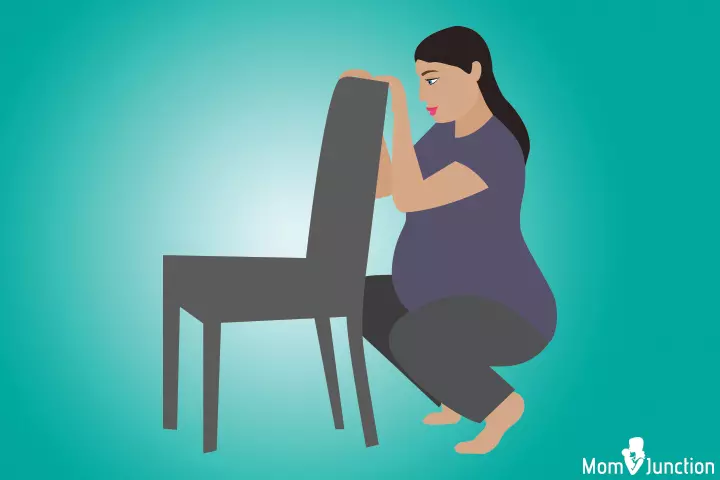
It can be done with the support of your birth companion, or a chair against the wall. Squat with your feet flat, and hold your partner or something sturdy for support.
Benefits
- Helps to open up the pelvis by 2cm.
- Allows you to shift your weight for comfort.
- Helps the baby move into an optimal position as gravity encourages movement.
Drawbacks
- Can be tiring.
6. The upright position
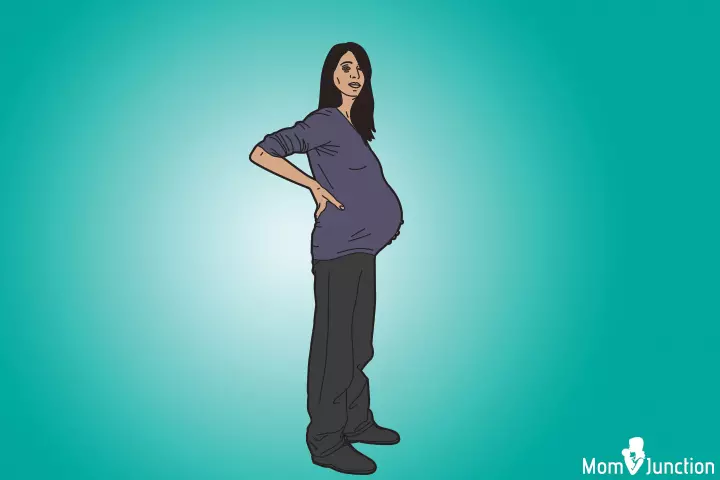
An upright position combined with the force of gravity is advantageous. It helps the baby drop deeper into the pelvis and prevents the pelvic pressure from concentrating in a certain area. Some upright positions include:
- Walking
- Swaying (leaning on a person)/ slow dancing
- Standing
- Rocking while sitting on a chair or the edge of a bed or a birthing ball
Benefits
- Helps relieve backache.
- Aligns the baby in the right position.
- Speeds up labor.
- Less painful contractions.
- The hip movement in slow dancing can increase the comfort.
Drawbacks
- Walking is not ideal if you have high blood pressure.
- Monitoring fetal heartbeat is difficult in positions like walking or swaying.
 Point to consider
Point to consider7. The stair-climbing position
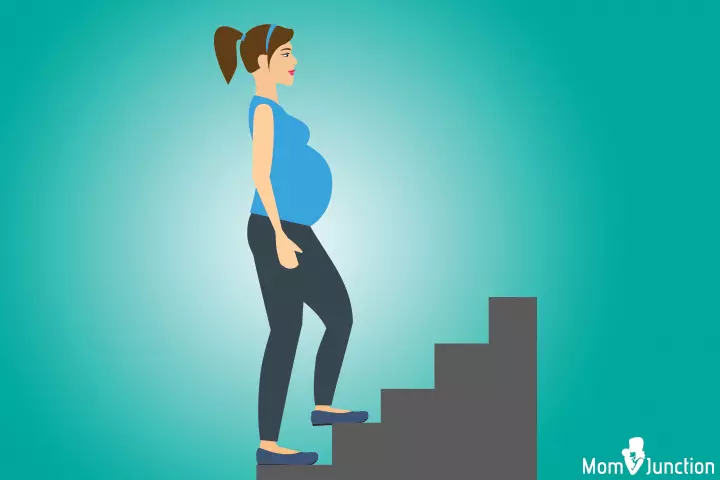
Climbing the stair during labor encourages the baby to move to the right birthing position. This asymmetric position offers enough room for the baby to move. But you need to hold to the railing and be careful.
Benefits
- Helps open the cervix.
Drawbacks
- Can be tiresome and risky.
8. The lunging position
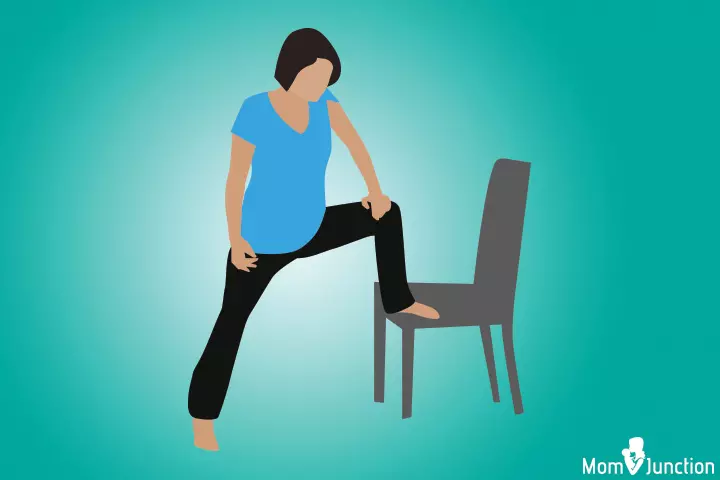
In this position, you must raise one of your feet and keep it on a chair. It helps in getting the baby to an ideal position, making it one of the best exercises to induce labor naturally. You can also do kneeling lunges if it is comfortable.
Benefits
- Helps rotate the baby and makes the descent easier.
- Opens up the mid pelvis.
- Relieves back pressure.
- Helps when the labor stops in between.
Drawbacks
- Needs support from the partner to keep balance.
9. Abdominal lift
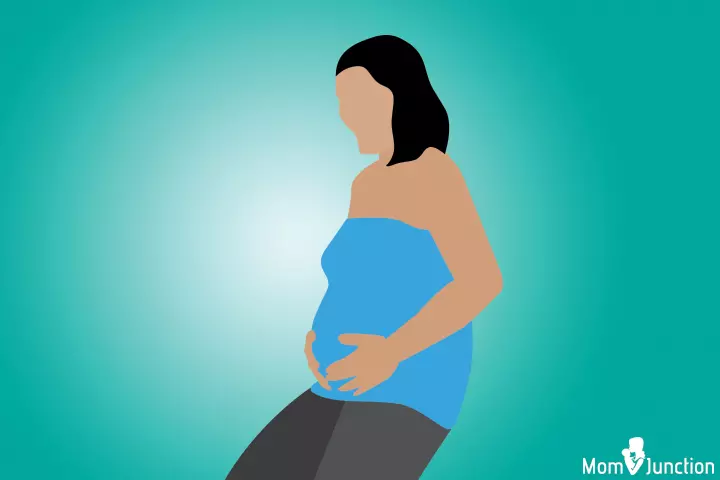
Hold your abdomen with both the hands from below and slowly move it up and down. Do it from the beginning to the end of the contraction. It helps in descending the baby into the pelvis.
Benefits
- Helps alleviate back and groin pain.
Drawbacks
- Needs your partner’s support.
10. Tailor sitting position
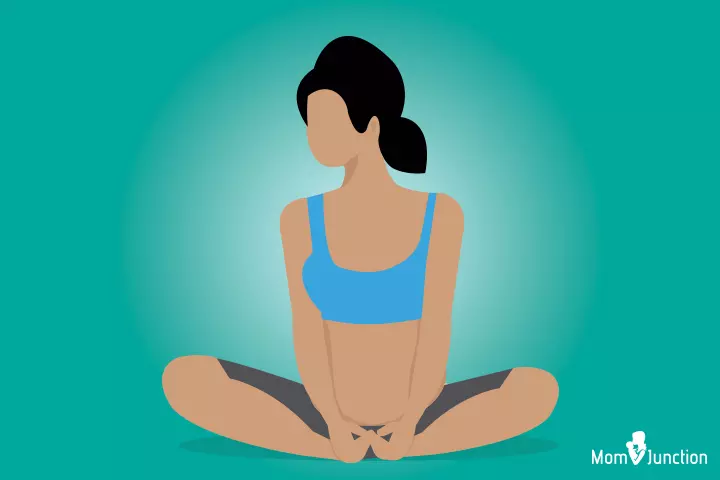
Sit on a flat floor with your knees bent while crossing your ankles, preferably on a mat. Lean forward gently to the point you feel your hip and thigh muscles slightly stretched. Keep your back straight throughout the time, and avoid applying pressure on your legs with your hands. Count to five and relax your muscles while sitting straight again (3) (4). You may try this position throughout pregnancy to ease pregnancy-related pains and discomfort.
Benefits
- Helps make pelvic, thigh, and hip muscles flexible.
- Ease labor pain and discomfort, and might help to get your baby in the right position.
Drawbacks
- Sitting on the floor with a big belly might be difficult.
- It might require your partner’s assistance.
Positions During The Second Stage Of Labor
As the second stage is associated with pushing, you can try these positions to lessen the discomfort (5) (6).
11. The semi-reclining position
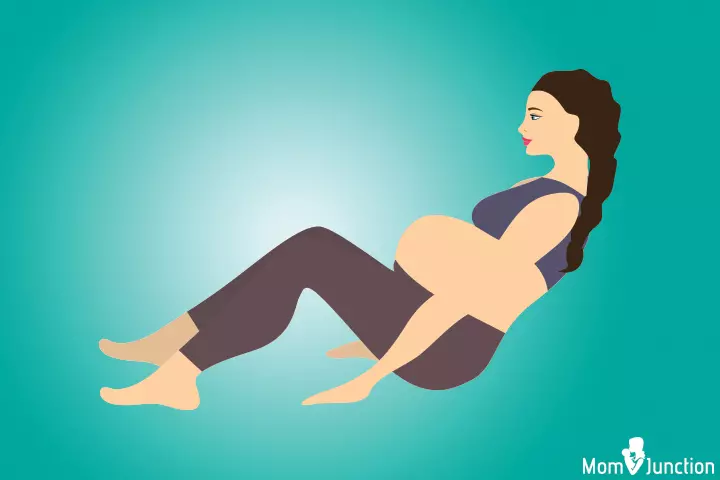
You can recline against a wall, chair, partner or a bed while the baby descends through the birthing canal. Keep your knees bent and spread with the foot flat on the ground. If you are taking the help of your partner, then recline against him at a 70-degree angle, positioning yourself on your back and not the rectum.
Benefits
- Helps release the tension on pelvic muscles.
- Good for women who feel tired and do not want to lie down.
Drawbacks
- This position may work against the forces of gravity.
- Not recommended during back labor.
12. The birthing bar
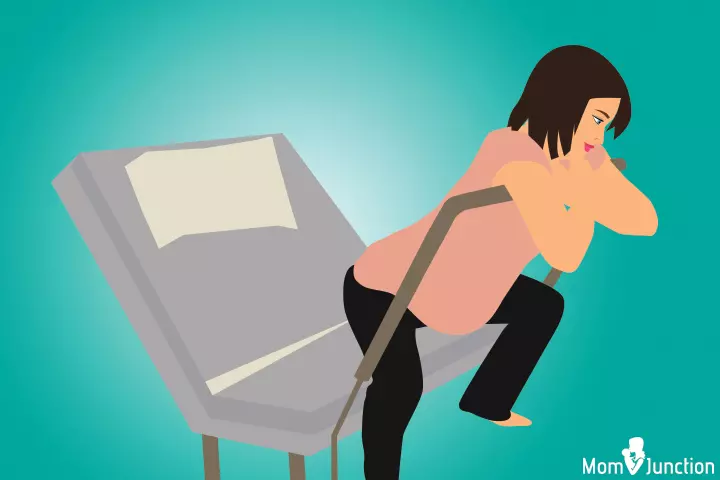
Labor beds with birthing bars can be of great support during the pushing stage. You can squat and lean over a birthing bar for support. The upper of the bed can be raised to lean back and relax in between the contractions.
If you are too short or cannot position yourself comfortably on the bar in a squatting position due to epidural effect, then rest your feet on the vertical support of the bar. Loop a towel on the horizontal bar and when you are having contractions, push with the grip of your feet on the vertical bar and holding the towel for support.
Benefits
- Helps widen the pelvis.
- Works with the gravity forces to push the baby down.
Drawbacks
- These attachments may not be available in all the hospitals.
13. The kneeling birth position

Lean over the head of the bed or a birthing ball and support yourself over the knees. During contraction, lower your buttocks and flex the hips to push.
Benefits
- Contractions are less painful.
- Relieves a backache.
- Offers good rest.
Drawbacks
- Continuous monitoring of fetal heartbeat becomes difficult.
- Arms may get tired.
14. The birthing stool
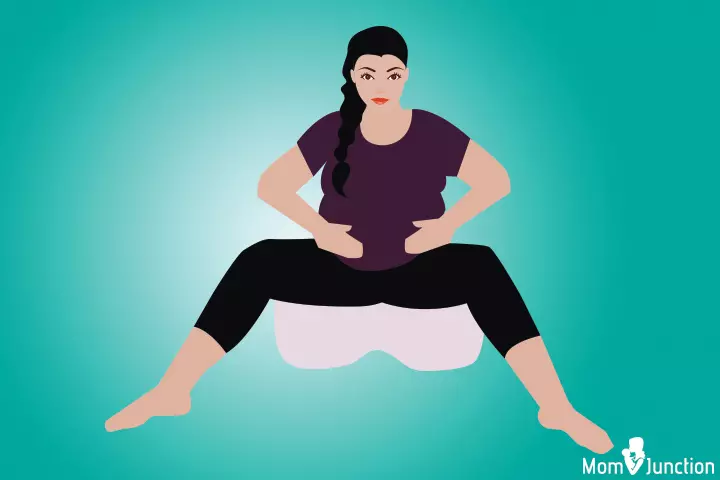
This position is similar to that you use in the toilet. It helps to angle your legs, thereby widening the pelvis to help the baby descend. A low-height stool is generally used for the position.
Benefits
- Works with gravity to promote the downward movement of the baby.
- Relieves stress on the back.
Drawbacks
- Needs labor support from your partner or doula.
15. The semi-sitting position

It is the most common position used during childbirth. It is also the most convenient position a woman can try during the pushing stages. Sit slightly tilted to the left by placing a pillow under your right hip. Lean forward with your knees held backward and the legs supported by the labor assistants and your partner.
Benefits
- Helps open up the pelvis effectively.
- Allows proper blood flow.
- Gives good visibility to the doctor.
- Fetal heart rate can be easily monitored.
Drawbacks
- Needs people to support you while trying this position.
16. Laboring in a tub

Getting into a bathtub of warm water helps you relax during labor, and eases the pain. Support your back against the tub and spread your legs wide open. Push during each contraction to promote the downward movement of the baby. You can also use a birthing ball to lean over.
Benefits
- Speeds up labor.
- Best to try when the contractions get closer.
- Gives a break from pain during slow labor.
 Did you know?
Did you know?Drawbacks
- Needs assistance from the doula or perinatal nurse.
17. Use of rebozo
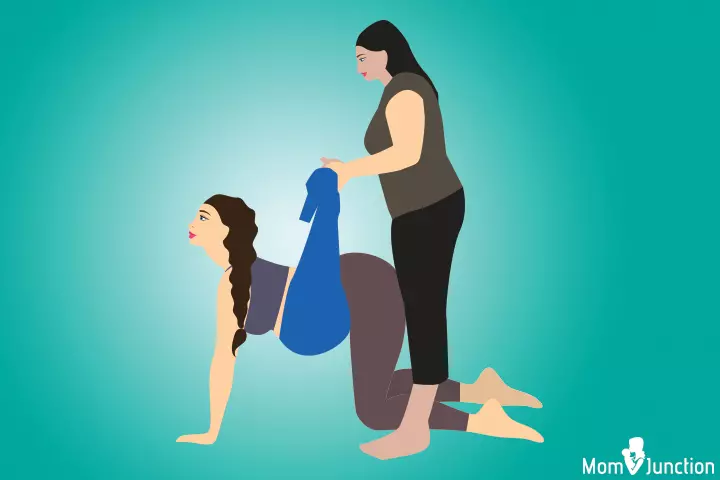
Rebozo helps turn the breech babiesiBabies whose feet or buttocks are positioned to come out of the vagina at first. during labor (7). Position yourself on the knees and hands with your partner holding a rebozo around your belly from behind. The rebozo needs to be gently moved from side to side to help rotate the baby.
Benefits
- Helps relieve back pressure and uterine ligament tension.
- Convenient for having a back massage.
Drawbacks
- Needs the partner’s help to wrap the rebozo around the belly.
- Discuss with your birth team or gynecologist about having a breech vaginal delivery as it can be associated with difficulties, and has the risk of the head getting stuck.
18. Lithotomy position
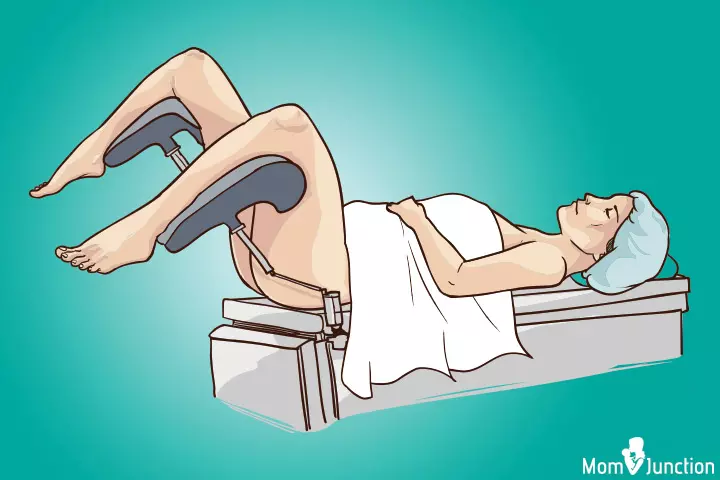
In this position, you need to lie flat on your back with the feet up supported on stirrups.
Benefits
- Helps the obstetrician to check your perineum and abdomen.
- Easy to check fetal heart rate.
- Makes assisted delivery using forceps or vacuum extractor easier.
Drawbacks
- Can reduce the diameter of the pelvic opening.
- The contractions can become irregular.
- The elevated legs can make the contractions lift your hips upward, which may push your baby inside.
- Higher chances of episiotomy.
- Lower blood pressure and less supply of oxygen to the baby.
Frequently Asked Questions
1. How do I push a baby out without tearing?
Pushing the baby gently and slowly may allow tissues to stretch and give way for the baby. Placing a warm cloth on the perineum (thin layer of skin between your genitals and anus) during the second stage of labor might also reduce the risk of vaginal tearing. Also, delivering in an upright and non-flat position may eliminate the risk of tearing (8).
2. Can I give birth without pushing?
It is possible to give birth without actively pushing. However it is uncommon, since during the second stage of labor, the mother’s body naturally begins to push the baby out with contractions. This stage is called the “urge to push” or “bearing down reflex”, in which the baby starts moving out of the birth canal. Although uterine contractions will naturally bring down the baby, some women may prefer to wait for a few hours until the baby’s head starts to emerge from the birth canal (9).
3. Does laying down slow labor?
Spending time on your bed by laying down or sitting up at a small angle, might affect labor progression. The blood circulation to your uterus decreases, thus, reducing effective contractions. The baby might be more likely to be settled in a posterior position due to opposite gravity (10).
4. How do I choose a labor position?
Your doctor or midwife will suggest a labor position based on several factors, including your health condition during delivery, the stage of labor, underlying medical conditions, maternal weight, and overall maternal comfort.
While labor isn’t pleasant, finding a comfortable posture can help you relax and exert the right pressure to shorten the time it takes. During labor, your delivery nurse, midwife, birthing coach, birth attendant or doctor can suggest various positions for you to try. However, consulting a birth advocate and understanding some of these positions beforehand may help you feel more confident and prepared during your labor. Also, you can practice some of these best positions for labor to get the hang of them.
Infographic: Best Positions To Try During Labor To Ease The Pain
Labor can be physically and emotionally demanding for expectant mothers. One way to manage the pain of labor is to try different positions. While the comfortable and effective positions will vary from person to person, some positions are generally considered helpful for easing labor pain. Explore the positions to manage your discomfort during the birthing process. Illustration: Momjunction Design Team
Some thing wrong with illustration image shortcode. please verify shortcode syntax
Watch this video as it explores the different birth positions. Learn how to make your labor and delivery experience as comfortable as possible.
Personal Experience: Source
MomJunction articles include first-hand experiences to provide you with better insights through real-life narratives. Here are the sources of personal accounts referenced in this article.
i. My labor routine | best labor positions to ease pain | positive birth stories.https://www.youtube.com/watch?v=4X_eGa04CCc&feature=youtu.be
References
- Labor Positions & Movement.
https://www.lamaze.org/labor-positions - Positions for labour and birth.
https://www.pregnancybirthbaby.org.au/positions-for-labour-and-birth - Positioning & Movement.
https://www.beaumont.org/treatments/positioning-movement - Tailor Sit, Trunk Turn for Back Pain During Pregnancy.
https://www.saintlukeskc.org/health-library/tailor-sit-trunk-turn-back-pain-during-pregnancy - Effective Pushing Techniques for Labor.
https://www.frive-games.com/ - Birthing Positions.
https://www.takingcharge.csh.umn.edu/birthing-positions - C Smith et al.; (1999); Knee-chest postural management for breech at term: a randomized controlled trial.
https://pubmed.ncbi.nlm.nih.gov/10687569/ - Preventing vaginal tear during childbirth
https://www.mayoclinic.org/healthy-lifestyle/labor-and-delivery/expert-answers/preventing-vaginal-tearing-during-childbirth/faq-20416226 - Laboring down.
https://my.clevelandclinic.org/health/articles/22959-laboring-down - What factors influence progression childbirth.
https://www.takingcharge.csh.umn.edu/what-factors-influence-progression-childbirth - Water Births.
https://americanpregnancy.org/healthy-pregnancy/labor-and-birth/water-births/
Community Experiences
Join the conversation and become a part of our nurturing community! Share your stories, experiences, and insights to connect with fellow parents.
Read full bio of Dr. Shweta Goswami
Read full bio of Sakshi Mishra
Read full bio of Rebecca Malachi
Read full bio of Dr. Joyani Das





